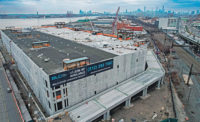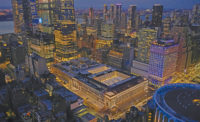Manhattan’s latest skyscraper project—a sleek tower that will taper on its way up to 1,050 ft—has a secret buried inside its walls.
The building, 53W53, on the rise beside the Museum of Modern Art in midtown, has embedded the keys to erecting an ultratall diagrid design within its concrete superstructure frame: a custom-designed set of steel boxes and plates that anchor an intricate central nervous system of structural support.
The 728,000-sq-ft condominium tower—designed by Pritzker Prize-winner Jean Nouvel for lead developers Hines, Pontiac Land Group and Goldman Sachs on a midblock site between Fifth and Sixth avenues—has numerous distinctive features, including how it will add 65,000 sq ft of gallery space to MoMA.
But the aspect most daunting for the project team, led by Lendlease as construction manager and WSP | Parsons Brinckerhoff as structural engineer, has been incorporating the steel “nodes” that allow the complicated twisting diagrid structure to function.
Essentially acting as junction boxes for high-strength steel rebar pieces coming together from multiple angles in nearly three dozen spots throughout the building, the critical pieces required extensive modeling and painstaking execution to design, build and install, says Nick Grecco, project executive for Lendlease.
Article Index:
The biggest node just happens to be positioned on the sixth floor, he says. “The heaviest and most complicated was the first one, so talk about trial by fire,” Grecco says. “That is an intersection of six different columns.”
As with most of the heavy steel nodes, project crews landed the largest one in place with a crane and kept it on the hook as they coupled the reinforcing bars—some coming in from angles sloping back north to south and east to west—into place. That left no wiggle room: Once the team poured concrete around the form, there was virtually no tolerance to move the piece, Grecco says.
“It was a staged pouring of concrete because the bars are so large,” he adds. “We couldn’t have a fraction of an inch at the wrong angle.”
That effort in early spring was a test for the whole project, says Tim Flynn, vice president of design and construction at Hines, the project developer. “If that didn’t fit, we were in a load of trouble on a tight schedule,” he says. “Everyone was holding their breath that day. But they got it to fit and have installed a bunch more since then—and haven’t lost [time] to put these into place.”
High Up, High End
The 82-floor tower is slated to open in 2018 and will ultimately have 145 luxury units ranging in price from $3 million to $73 million and add three floors of gallery space to the museum. Crews were pouring concrete at around the 20th floor in November, and the project team expects to hand over MoMA’s space for interior work in early 2017 and to top out on the entire structure in early 2018. But it has been a long time in the making.
The building first took shape in concept a decade ago, when MoMA decided to move ahead with another expansion, following a 2001 effort, says David Penick, managing director at Hines. It sought developers for the 17,000-sq-ft site west of the museum and sold the lot to the Hines and Goldman Sachs development team at the end of 2006, which after a competition, chose Nouvel’s design, he says.
But at the time, the project then known as Tower Verre, was supposed to rise to 1,250 ft, nearly equal to the Empire State Building. Opposition quickly formed as neighbors in midtown, legislators and planning officials objected to the project’s scale. After negotiations, the City Council approved the 1,050-ft version in 2009 although it has architectural elements that will reach 1,113 fit.
The 2008 financial crash also slowed the project’s momentum, Penick says. Work started up again a few years later, with a big investment round in 2013 that brought in $1.1 billion in equity and debt financing from Pontiac Land Group and others, according to news reports. Hines declines to provide an official project budget.
By then, the full team was coming together, with WSP | PB brought in to map out a structural engineering plan, Lendlease for preconstruction and other design team members joining—including Adamson Associates Architects of Toronto for production design and Thierry Despont and SLCE Architects on interior design.
Work soon began on foundations in fall 2014 and finished late last year, Grecco says. The two-level basement’s biggest challenge was proximity to a subway tunnel and other facilities for New York City Transit right along 53rd Street, which required many preventive and compensatory measures, he says.
The project features 33 36-in.-dia caissons in the foundation—many at 30 ft but some up to 70 ft in depth to match the level of the subway track bed, Flynn says. “We excavated quite a bit of rock to go down two cellars,” he says. And by the time the foundation was done, work was already underway on the superstructure, Grecco says.
Slender and Strong
The building’s slim profile and slightly twisting structure emerged from the blend of the diagrid design with the tower’s height, and a key early concept was placing wind-bracing elements on the perimeter, Penick says.
“There was a lot of careful and thoughtful structural engineering to realize that image and for structural efficiency and integrity,” he says. “It proved to be a very efficient system, ensuring Jean Nouvel’s vision of the building and making it buildable, both economically and in terms of schedule.”
Early on, the engineering team had discussed how to achieve Nouvel’s design with the Hines team and looked at various options before deciding concrete was the most effective path, says Silvian Marcus, director of building structures at WSP | PB. Factors such as floor heights, weight, total cost and even labor union coordination went into the planning in 2011 and 2012, he says.
Whereas a typical concrete superstructure takes weight from columns down to the ground, the diagrid allows inclined columns to carry some of the load and provide lateral stability for wind, Marcus says. “So we have one system that responds to two needs,” he says. “From an engineering point of view, that’s a perfect system.”
Building it was another matter, which ended up requiring extensive planning. After about a year of modeling, the team developed the nodes to connect the No. 20 round, grade 97 steel rebar pieces, which are encased in 14,000 psi concrete at the shear walls and columns, with each node custom built for its specific location.
“We realized the importance of the joint, the node, and put a lot of energy into developing it,” Marcus says.
The final product came together with WSP | PB’s design, Lendlease’s modifications to lighten the steel boxes, fabrication offsite by SAS Stressteel and concrete erection by Sorbara Construction.
“These nodes and the diagrid really provide rigidity to the building that normally might be handled only with tremendous shear walls,” Flynn says. In other places, the structure has shear wall elements that require the Sorbara team to bend rebar at angles, which curbed the need for additional nodes, he adds.
High Points
More big construction challenges lie ahead. One is the huddle of major equipment at the apex—including a cooling tower, 500-ton tuned mass damper, elevator machine room, fans, pumps and window washing rig, all within the building’s steel top portion, Grecco says.
“It is jam-packed at different levels,” he says. “All of those are in a building tapering to a point. It’s building a Swiss watch where a hoist can’t even access it.”
The 5,747 curtain-wall panels of various shapes and sizes, built by Enclos, are another major task, Penick says. “There are so many non-rectangular components,” he says.
Fabricating the panels and installing them is complicated by the building’s sloping angles and diagonal columns, Flynn says. “This is not a square building, and [panels] all have to fit into place,” he says.
The luxury interiors are another big job, with most units having cut stone and high-end finishes, Grecco says.
A duplex penthouse on the 81st and 82nd floors with a double-height living room and great view of Central Park will be a prized offering, Penick says.
Interior work on the museum’s floors, meanwhile, takes place early next year. A notable feature in MoMA’s portion will be a generous floor space with only two columns, made possible by two tremendous steel transfer trusses at the sixth and eighth floors, and one of the columns being made of 36-in. by 36-in. solid steel, Flynn says.
Installing those pieces in early spring was an achievement worthy of artistic appreciation. “For days, it was people working right on top of each other,” Flynn says. “And we maintained schedule and nobody got hurt. It was controlled chaos.”











Post a comment to this article
Report Abusive Comment